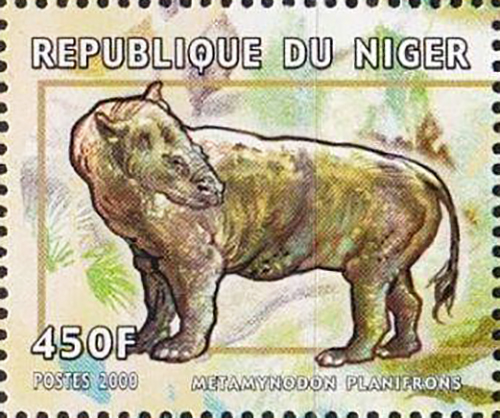Metamynodon planifrons Scott & Osborn 1887

(Da: it.wikipedia.org)
Phylum: Chordata Haeckel, 1874
Subphylum: Vertebrata Cuvier, 1812
Classe: Mammalia Linnaeus, 1758
Ordine: Perissodactyla Owen, 1848
Famiglia: Amynodontidae Scott & Osborn, 1883
Genere: Metamynodon Scott & Osborn, 1887
Specie e sottospecie
Il genere annovera attualmente le seguenti specie: Metamynodon chadronensis Wood 1937 - Metamynodon mckinneyi Wilson & Schiebout 1981.
Descrizione
Questo animale era un perissodattilo primitivo, e in particolare le sue parentele vanno ricercate nel gruppo dei rinoceronti. Le sue caratteristiche, però, lo denotano come un animale strettamente anfibio. Il corpo era particolarmente allungato e a forma di botte, le zampe erano piuttosto corte e tozze. Il cranio, diversamente da quello dei rinoceronti attuali, era privo di corna, era lungo e basso e possedeva quattro forti canini, usati forse come display intraspecifico in combattimenti rituali. Il metaminodonte, inoltre, era dotato di un cervello davvero minuscolo. Con tutta probabilità il metaminodonte e i suoi parenti (gli aminodontidi) vivevavo in un modo molto simile agli odierni ippopotami. Questi animali si estinsero quando un altro gruppo di rinoceronti più specializzati (ad esempio i Teleoceras) si insediò negli stessi habitat e andò a occupare la medesima nicchia ecologica.
Diffusione
Mammifero estinto, vissuto nell'Eocene in Nordamerica.
Bibliografia
–"Metamynodon". Fossilworks.
–Wall, William P. (1989). "The phylogenetic history and adaptive radiation of the Amynodontidae". In Prothero, Donald R; Schoch, Robert M. (eds.). The Evolution of perissodactyls. Oxford University Press.
–Tissier, J.; Becker, D.; Codrea, V.; Couster, L.; Farcas, C. (2018). "New data on Amynodontidae (Mammalia, Perissodactyla) from Eastern Europe: Phylogenetic and palaeobiogeographic implications around the Eocene-Oligocene transition". PLOS ONE. 13 (4): e0193774.
–Wall, W. P.; Heinbaugh, K. L. (1999). "Locomotor adaptations in Metamynodon planifrons compared to other amynodontids (Perissodactyla, Rhinocerotoidea)" (PDF). National Parks Paleontological Research. 4: 8-17.
–Scott, W. B.; Osborn, H. F. (1887). Preliminary Account of the Fossil Mammals from the White River Formation contained in the Museum of Comparative Zoology. Bulletin of the Museum of Comparative Zoology. pp. 165-169.
–Forster-Cooper, C. (1922). "LXXIV.—Metamynodon bugtiensis, sp. n., from the Dera Bugti deposits of Baluchistan.—Preliminary notice". Annals and Magazine of Natural History. 9 (53): 617-620.
–Prothero, D. R.; Schoch, R. M. (2002). Horns, Tusks, and Flippers: The Evolution of Hoofed Mammals. JHU Press. p. 258.
–Wilson, J. A.; Schiebout, J. A. (1984). Early Tertiary Vertebrate Faunas Trans-Pecos Texas: Amynodontidae (PDF). Pearce-Sellards Series. University of Texas. pp. 48-52.
–"Paleobiology Database: Metamynodon planifrons". Archived from the original on 2012-07-20.
–Palmer, D., ed. (1999). The Marshall Illustrated Encyclopedia of Dinosaurs and Prehistoric Animals. London: Marshall Editions. p. 264.
–Wall, W. P.; Collins, C. M. (1998). "A comparison of feeding adaptations in two primitive ruminants, Hypertragulus and Leptomeryx, from the Oligocene deposits of Badlands National Park" (PDF). National Park Service Paleontological Research: 13-17.
–Benton, R. C.; Terry, Jr., D. O.; Cherry, M.; Evanoff, E.; Grandstaff, D. E. (2014). Paleontologic Resource Management at Badlands National Park, South Dakota: A Field Guide for the 10th Conference on Fossil Resources (PDF). National Park Service.

|
Data: 27/10/2000
Emissione: Animali attuali e ancestrali Stato: Niger Nota: Emesso in un foglietto di 6 v. diversi |
|---|